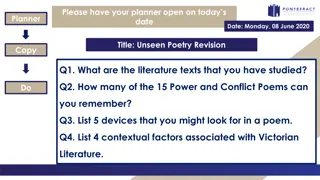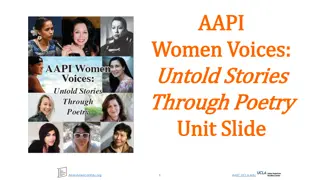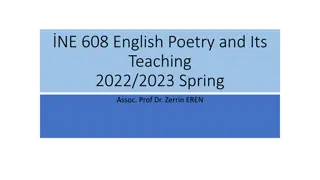Exploring the Theme of Imperfection in 'The Circle' Poetry
Delve into the intricate portrayal of imperfection in the poem 'The Circle'. The poet's use of enjambment and vivid imagery conveys a sense of awe towards the universe while also exploring the protagonist's struggle with imperfection, tying it back to personal experiences. Through the interplay of cosmic elements and personal reflections, the poem unfolds with layers of meaning and emotions, ultimately highlighting the beauty in imperfection.
Download Presentation

Please find below an Image/Link to download the presentation.
The content on the website is provided AS IS for your information and personal use only. It may not be sold, licensed, or shared on other websites without obtaining consent from the author.If you encounter any issues during the download, it is possible that the publisher has removed the file from their server.
You are allowed to download the files provided on this website for personal or commercial use, subject to the condition that they are used lawfully. All files are the property of their respective owners.
The content on the website is provided AS IS for your information and personal use only. It may not be sold, licensed, or shared on other websites without obtaining consent from the author.
E N D
Presentation Transcript
The Circle Sense of pride in the opening line My boy is painting outer space, and steadies his brush-tip to trace Use of a list: Jamie wants to draw them all! the comets, planets, moon and sun The use of lots of enjambment allow Paterson to fit his rhymes in, but also link to the heavenly design mentioned in the second stanza. The line spilling over could suggest the enormity of the universe and everything in it. It is as if it all cannot be contained. This could also be read as introducing a sense of imperfection that will continue through the poem. and all the circuitry they run circuitry" suggests an electronic circuit made up of the planets that are connected in circular orbits; it also loops us back to the title.
Design links to him drawing but also to a creator. in one great heavenly design. But when he tries to close the line he draws around his upturned cup, his hand shakes, and he screws it up. Screws it up is the child s frustration rendered in the child s language: the momentary loss of control implies that control was his to lose. Double meaning: he messes it up, but also could lose his temper and scrunch up the paper as a result of his mistake.
The tremor in Jamies hand sparks an exploration of the contrast between what we can anticipate and the inevitably other reality that follows.
Background: Jamie had a difficult birth. "The shake" explains the reason he must "steady" his brush in stanza one and why he messes up the circle. It suggests that like the drawing, Jamie himself is flawed. Perhaps Paterson sees his son as his imperfect creation, just as the drawing is Jamie s. Use of parenthesis adds Paterson s thoughts, but God isn t capitalised, suggesting that while he alludes to a higher being, he might not necessarily believe in one. The shake s as old as he is, all He was so close to being completely fine and safe when this happened, just as all is going well until the very last minute. (thank god) his body can recall of that hour when, one inch from home, we couldn t get the air to him; Inclusive pronoun indicates Paterson, the family and the medical staff.
Back to the present-day and present tense: the use of he suggests he is not only enjoying the freedom, but he is all the world, everything, to the speaker. Repetition of breathing-space and breath, to emphasise he has the time and space and though today he s all the earth and sky for breathing-space and breath the whole damn troposphere can t cure Damn : indicates frustration The troposphere: the space above the layers in the atmosphere. All of this is available, but can t fix Jamie the flutter in his signature. This flutter takes us back to the minor imperfection in him.
The pivotal use of "But", the poem shifts from describing Jamie's personal experience to addressing the boy directly. We collectively meaning nothing is what we want it to be, or planned perfectly. He isn t the only one who is angry about their plan not working out. Interesting use of nothing here, suggesting that nothing turns out the way we mean it to, but also that this very consequence is 'meant' to be. This is what makes us human. Double meaning: it could be "taxed" as in strained, but also "taxed" as in a financial tax. This suggests a part of our dreams are taken away, that doesn t work as planned. We don't quite achieve our complete aspiration: we always lose some of it. But Jamie, nothing s what we meant. The dream is taxed. We all resent the quarter bled off by the dark between the bowstring and the mark Part of our plan is lost to "the dark", possibly the darkness of space. "Bled" implies an injury and how fragile human life is. It could also refer to the paint Jamie is using to paint, mixing his colours. Paterson uses the metaphor of shooting an arrow to describe our actions in life and how we are shooting in the dark. The "bowstring" suggests the moment a person takes aim, when they make their plan. But once the arrow is released it is out of our control.
We are meant to understand before the boy will. Krishna Krishna, the Hindu god of love and compassion, was the eighth avatar of the Indian god Vishnu. He was shot by a hunter's arrow and was fatally wounded. This links back to the "bowstring" and bleeding imagery of the previous stanza.
and trust to Krishna or to fate to keep our arrows halfway straight. But the target also draws our aim our will and nature s are the same; This suggests that the target has its own intentions on the shooter. This brings us back to fate "our will and nature's are the same" we are as we were meant to be.
Paterson makes clear we are not entirely powerless. Fate may have written a book for us but we are living . This suggests we can influence what happens to us. "living word" usually refers to the 'Word of God' so the suggestion is that our beings are bound up with the very fate that determines existence. The book could denote any spiritual text, while "its fourteen- billion-year-old song" refers to the age of our universe. we are its living word, and not "Song" makes us think of a melody or patterning that is passed from generation to generation like poetry itself. We might conclude from this that whether we realise it or not there is some force at work in our actions, in our "right and wrong" and it might even be ourselves. a book it wrote and then forgot, its fourteen-billion-year-old song inscribed in both our right and wrong
At this point, Paterson returns to the personal anecdote that begins the poem: his son's drawing. The child's fist coming "down like a stone" has a sense of finality about it, as if he wants to give up. There is a perhaps a biblical link here to the stone that sealed Christ's tomb. In this sense, we might read the final stanza as a sort of resurrection when the stone of despair is rolled away to reveal something miraculous. so even when you rage and moan and bring your fist down like a stone on your spoiled work and useless kit, you just can t help but broadcast it: Linking back to the ruined picture from before I wonder how loud his tantrum is?
Paterson directs his son and the reader to look to the jar and to find "the perfect ring" which has been there all along. Here is the perfection, which has been created without even trying
An Avatar is a manifestation of a deity or released soul in bodily form on earth; an incarnate divine teacher according to Hinduism. Whether it is down to science, or fate or some kind of god, perfection is now to be found in the "muddy water-jar" in the humblest thing. look at the little avatar The "muddy" water suggests the mud from which the God of the Old Testament moulded Adam and Eve. of your muddy water-jar filling with the perfect ring "under everything", which implies it is hidden and that it will accompany us whether we have high aspirations or not. singing under everything. Again he refers to "singing" as if this "living" voice is always there, if we just listen to it.
But the final point to make is that, despite its perfection, the ring exists in muddied water and therefore isn t perfect. We must accept therefore that perfection is found in imperfection - after all that is what it is to be human.
In this poem, Paterson uses the somewhat ordinary event of his boy trying to draw "outer space" to explore deeper thoughts about humanity and our fate. The striking and simple image of the circle runs throughout the poem, moving from the boy's imperfect circle drawn with his shaking hand, to the "circuitry" of the planetary system and life itself, to the final "perfect ring" achieved by end of the poem. This and Paterson s use of clever language and knowledgeable allusions (to the "troposphere", "Krishna", the "fourteen-billion-year-old" universe) recall the poetry of John Donne. The poem also considers the fragility of existence, reminding us of his son's precarious entrance into the world and that no matter how hard we try we must still accept the "quarter bled off by the dark" as that is the design of the universe.
Paterson structures the poem as nine quatrains with a strict rhyme scheme and rhythm. Apart from a few slant rhymes he uses a tight AABB rhyme throughout. Perhaps the combination of full rhymes and half rhymes relates to the theme of perfection and imperfection that permeates the poem. The rhythm is for the most part iambic tetrameter, similar to that used by John Donne. The word "tetrameter" simply means that there are four feet in the line; iambic tetrameter is a line comprising four iambs: pairs of syllables made up by an unstressed syllable followed by a stressed one.
This gives the poem a set frame within which Paterson explores philosophical ideas; it could imply that no matter what we think or how much effort we put into influencing the course "our arrows" take, we are still held within the confines of fate s design. In the first four stanzas, Paterson describes his son drawing as an outside observer. In stanza five with the pivotal use of "But", the poem shifts from describing Jamie's personal experience to addressing the boy directly. Paterson moves from talking about his son to addressing a more universal concern in terms of how we all deal with what we are given. Overall, the poem's structure also has a 'circular' feel to it, as it begins with the boy's poorly drawn circle and ends with the "perfect ring", which gives it a sense of completion.























